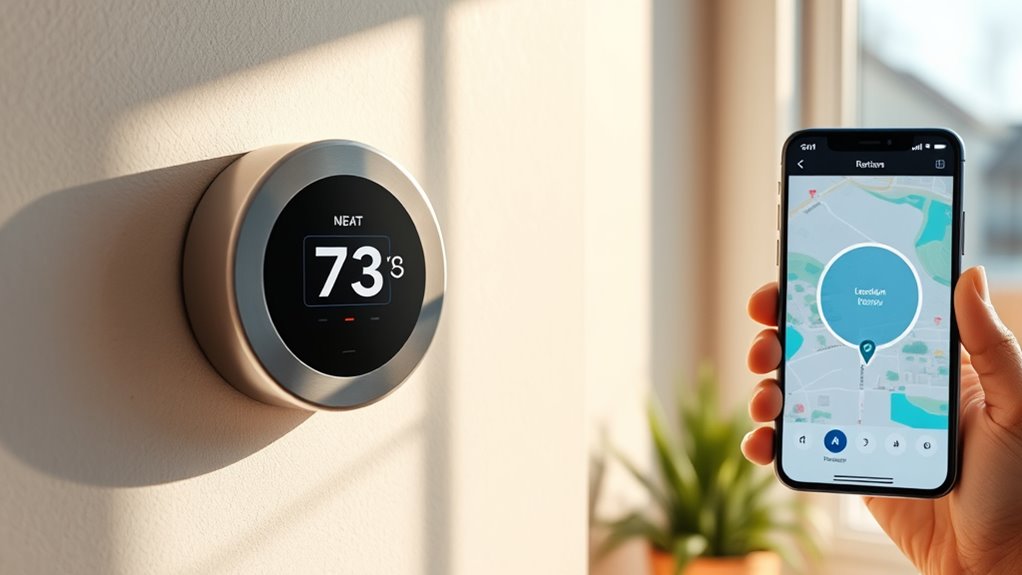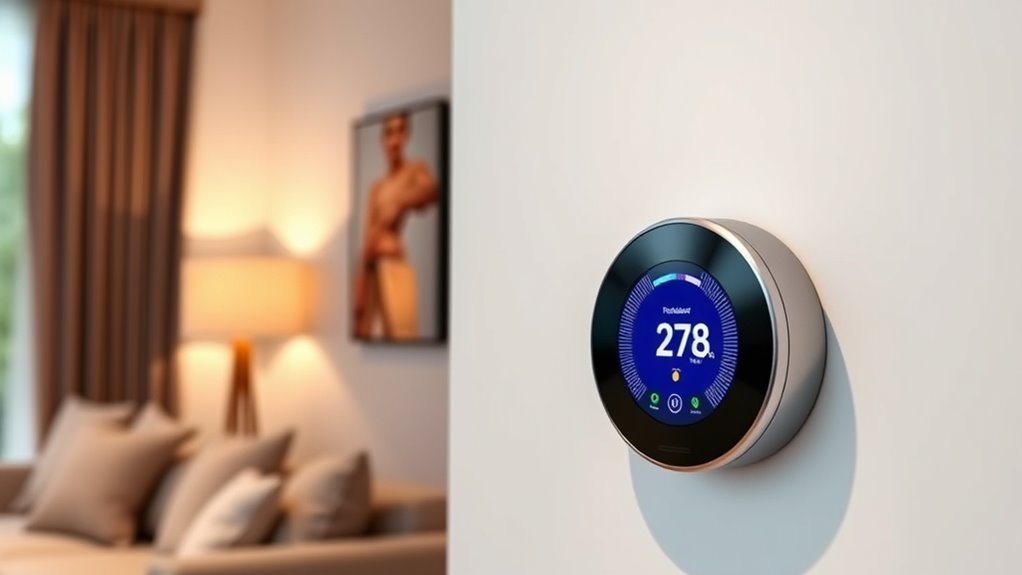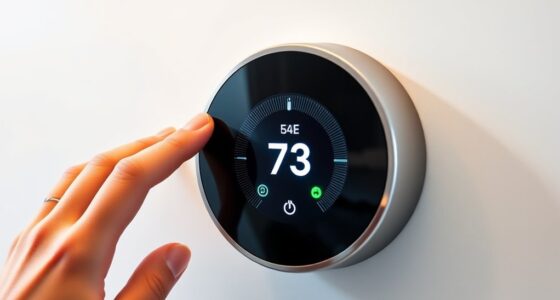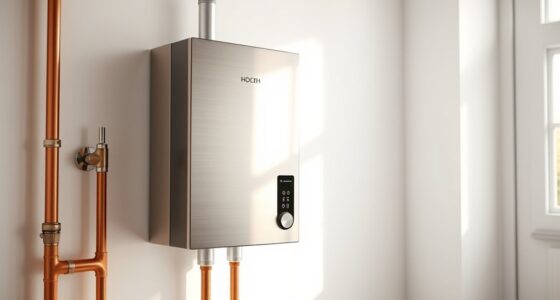Your smart thermostat uses geofencing technology to detect when you arrive home or leave. It relies on your smartphone’s location signals from GPS, Wi-Fi, and cellular networks to know your movements. When it senses you’re nearby, it automatically adjusts to a comfortable temperature; when you leave, it can conserve energy by lowering settings. If you want to discover how this technology works in detail, keep exploring these innovative features.
Key Takeaways
- The thermostat uses geofencing to create a virtual boundary around your home based on your smartphone’s location.
- It detects when your device crosses the boundary, indicating you’re arriving or leaving.
- GPS, Wi-Fi, or cellular signals from your phone communicate with the thermostat to determine your proximity.
- When you enter the geofence, the thermostat automatically adjusts settings to prepare for your arrival.
- Upon departure, it can revert to energy-saving modes, ensuring comfort and efficiency based on your presence.

Have you ever wondered how businesses send targeted offers when you’re nearby? It all comes down to location tracking, a technology that allows devices to know where you are with remarkable precision. When you walk into a shopping mall or pass by a coffee shop, that store might send you a mobile alert with a special discount — all thanks to geofencing. This technology creates a virtual perimeter around a physical location, and when your smartphone crosses that boundary, your device receives a notification. This is how businesses engage you with timely offers, making marketing more personal and immediate.
Geofencing enables nearby businesses to send targeted offers through location-based notifications.
But geofencing isn’t just for marketing. It’s also crucial for smart home devices, like your thermostat. Your smart thermostat uses geofencing to know when you’re approaching home, adjusting the temperature accordingly. This automation hinges on location tracking, which continuously monitors your device’s position relative to your house’s virtual boundary. When your phone enters this designated zone, the system triggers an action — in this case, increasing or decreasing the temperature — without you lifting a finger. It’s all about convenience and energy efficiency, and it relies on mobile alerts to inform you of changes or updates from your device.
The process behind this is pretty seamless. Your smartphone communicates with the thermostat’s app or system via GPS, Wi-Fi, or cellular signals, providing real-time location data. When you cross into the geofence, the thermostat receives a signal, and a predefined command is executed. You might get a mobile alert confirming the change, or simply enjoy the comfort of arriving home to a cozy environment. This integration of location tracking and mobile alerts creates a smooth, intuitive experience that feels almost automatic.
Geofencing also helps in security systems. If you leave your home, a system might send you a mobile alert warning you of unusual activity or remind you to lock doors. When you return, it can disarm the alarm once it detects your presence. This ongoing communication relies heavily on location tracking to ensure your home’s safety and your peace of mind.
In essence, geofencing combines location tracking and mobile alerts to make technology smarter and more responsive. Whether it’s a retail store sending you a coupon or your thermostat adjusting temperatures as you arrive home, it’s all about using virtual boundaries to create a more connected, efficient environment. As these systems become more advanced, you’ll find yourself relying on them more often, enjoying convenience that’s precisely tailored to your movements and habits. Additionally, the integration of high-precision projectors into smart home setups can further enhance your living experience by providing immersive visual environments when needed.
Frequently Asked Questions
How Accurate Is Geofencing in Detecting Your Presence?
Geofencing’s accuracy depends on GPS signals, which can sometimes be affected by signal interference or poor reception. When your device’s GPS is precise, geofencing can detect your presence within a few meters, making it quite reliable. However, if there’s signal interference or weak GPS accuracy, it might delay or misjudge your arrival or departure. So, while generally effective, it’s not perfect and can occasionally have inaccuracies.
Can Geofencing Work With Multiple Users in the Same Household?
Like a savvy detective on a vintage TV show, geofencing can handle multiple user detection in your household. It uses household presence sensing to recognize when different members arrive or leave. While it’s effective, some systems might struggle with perfectly syncing everyone’s presence. Still, most modern thermostats can adapt, adjusting settings based on when any or all users are home, making your living space smarter and more energy-efficient.
What Privacy Concerns Are Associated With Geofencing Technology?
When using geofencing technology, you might worry about privacy concerns like data security and user consent. You should be aware that your location data is collected and stored, which could be vulnerable if not properly protected. It’s important to give informed user consent and review privacy policies. By understanding how your data is handled, you can better protect your privacy while enjoying the convenience geofencing offers.
How Does Geofencing Differ From Other Home Automation Triggers?
You might wonder how geofencing differs from other home automation triggers. Unlike simple timers or manual switches, geofencing uses your device’s location awareness to activate triggers only when you enter or leave a specified area. This provides trigger specificity, making automation more personalized and efficient. It responds dynamically to your movements, ensuring your home adjusts settings precisely when needed, enhancing convenience and energy savings.
What Factors Can Interfere With Geofencing Performance?
You might notice geofencing performance gets disrupted by factors like a weak GPS signal or unreliable Wi-Fi connection. When your GPS signal is weak, your device struggles to accurately detect your location, causing delays or missed triggers. Similarly, if your Wi-Fi connection drops or is unstable, your thermostat may not receive location updates promptly. Keeping your device’s GPS and Wi-Fi robust helps guarantee your geofencing setup works smoothly.
Conclusion
Understanding geofencing helps you see how your thermostat automatically adjusts when you arrive home, saving energy and boosting comfort. Did you know that over 70% of smart home devices now incorporate geofencing features? This technology’s growing popularity shows how seamlessly it fits into daily life, making home management smarter and more efficient. By leveraging geofencing, you’re embracing a future where your home responds intuitively, giving you more convenience and control than ever before.









